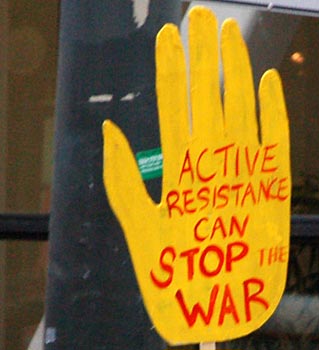
Yesterday morning, Act Against Torture demonstrated outside Senator Diane Feinstein's office in downtown San Francisco to protest her continuing support for the Iraq war and to demand an end to torture as U.S. policy. While over one hundred supporters cheered, protesters set up a theatrical Guantanamo in the middle of Market Street, snarling traffic for half an hour. The SFPD quickly acted their part, arresting seventeen who would not leave the street when ordered. My photo essay follows my reflections on the action.
I found the morning's event challenging. After allowing myself to get arrested in various symbolic protests against U.S. wars on the peoples of Central America in the 80s, I've avoided these set piece protests for the last decade or so. (I've been arrested since for various labor union actions, but that is a very different experience: less an act of individual conscience, more an intentional, well-resourced escalation of struggle by an organization with legal and financial backup.)
Too often peace movement arrests have seemed to me mechanical, drained of any inherent oppositional significance except for the individuals who "risk arrest," in the vernacular of protest. I haven't wanted to "risk arrest" -- if I was going to get hauled away, I wanted to have "done something" that made more than a symbolic statement. And, being honest with myself, I haven't wanted to incur real jail time; that would be the consequence of most actions I'd consider "real."
But although yesterday's action was symbolic (and I certainly hope the city of San Francisco doesn't try to exact any serious penalty for a small traffic jam), it seemed to me to hold promise for the antiwar and anti-torture movement. Even as most people in the U.S. realize the futility of the Iraq war, the movement has too often been stuck between two extremes of action: big national and regional antiwar rallies at least twice a year and/or endlessly lobbying cowardly Democrats to re-insert their spines and oppose Administration crimes.
Yet at this stage, the important work may have to go on between those two extremes -- we need to find a middle ground of activity to deepen commitment for a long struggle against the horrors that are U.S. policy. Right after 9/11, non-violence activists and peace movement veterans all over the country put up regular little vigils whose broadest message was "our grief is not a cry for war." As the wars escalated, we turned to the rally/political action paradigm. Last summer Cindy Sheehan created a powerful "middle ground" alternative by camping out in Crawford to give a face to families of the troops caught up in the horror show.
Vivid, imaginative anti-torture protests might just do the job of giving broader focus to the public's disaffection with the losing Iraq war. Peace activists know we are confronting more than just immediate "abuses." We've got a whole imperial structure to turn around and that requires being open to new oppositional opportunities at different moments in time. While continuing to afflict recalcitrant Democrats and showing our strength in mass rallies, we need to connect people to new ways for the U.S. to be in the world on many levels.
Our government's embrace of torture still appalls majorities in the U.S. When we denounce torture we place ourselves actively on the side of the voiceless global majority that doesn't control the powerful in either their own states or the U.S. That is the right place to be -- and among those folks is where the U.S. antiwar movement will find its allies. Food for thought...
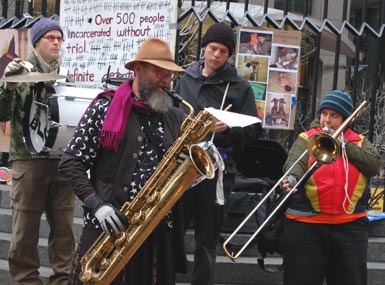
It is a lot easier to gather a crowd at 7 am when you have the Brass Liberation Orchestra waking folks up.

Architectural flourishes offered decorating opportunities.
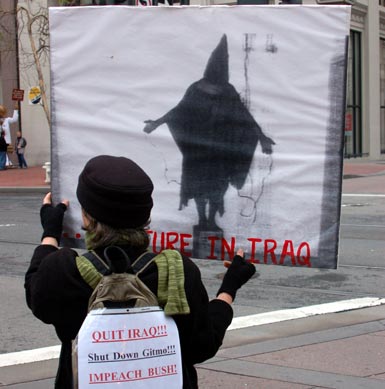
It shouldn't have been hard for passersby to figure out what this was about.

After a very little speechifying, protesters began crossing the streets.
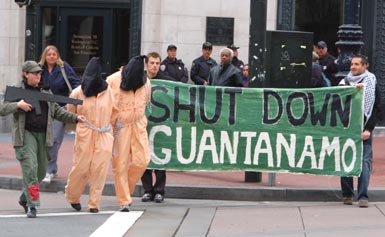
They were soon joined by iconic actors.


Pretty soon, there was a whole "Gitmo" set up in the middle of rush hour on Market St.
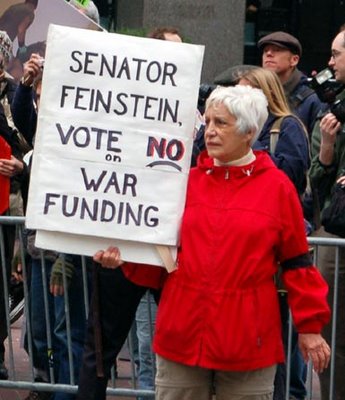
Some protesters didn't need to be part of the theater piece.
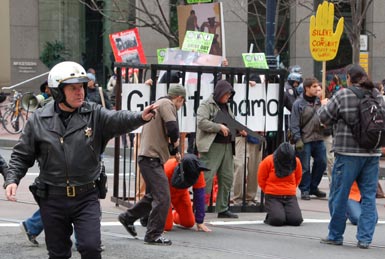
Police played their roles and traffic stopped dead.
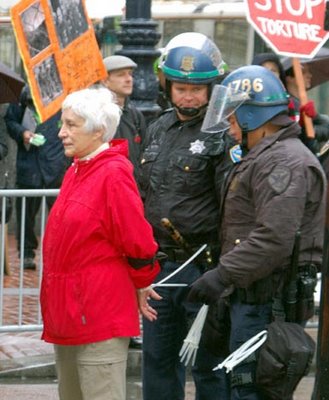
As it began to rain, arrests began.
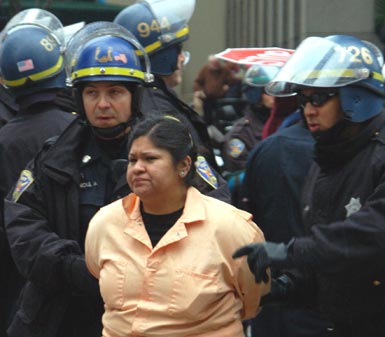
Soon the "detainees" were really prisoners.
For what it is worth, yesterday Senator Feinstein moved away from her hard pro-war position, urging that Bush fire Rumsfeld and scale back troop numbers in Iraq. She still has a ways to go though.... And this morning I got an email from Senator Barbara Boxer announcing that she has signed on to the Feingold censure resolution. Let's keep on pushing.
4 comments:
Hmm good on you for your own protests..you sound like quite the actvist. The discussion on use of force always makes me uneasy..one comes to the mind that that using torture you can make anyone say anything eventually..so whats the point? Other times I think under extreme circumstances to get information that cold save peoples lives i personally might not think twice..I suppose the fine line begins when it becomes institutional policy to use violence to get information from people..
that reminds me of the quote With the first link, the chain is forged. The first speech censored, the first thought forbidden, the first freedom denied, chains us all irrevocably
Glad to see you highlighting Guantanomo. Australia has one remaining prisoner there, David Hicks. Britain brought home its citizens but the Australian Government has refused to lift a finger. He is one listed to come before the disreputable Military Commissions and is made out to be a major, evil person - a bit hard to believe, really. These are the times in which we live. We still need the marches, the demonstrations, the people on the streets, the public-ity events. But we need more sophisticated tools that can become part of policy reality. Like Geldof and Bono have lifted the poverty/aid issue to a quite sophisticated level which has great potential power to effect change and has brought the issue to people who would not necessarily be activists, so peace activists need to be lifting their game to bring sophisticated peace tools into the halls of power.
Dear Jan: Absolutely wonderful photos, the first I've seen that really give a good picture of the theatrical protest. The essay preceding was also interesting.
Your next assignment: weaving the two together seamlessly.
By the way, I love the African story further up in the blog. So much of the info we get (or don't) out of Africa is filtered through White, Western eyes and it all feels askew. I want to see it from the inside.
You want some music for the next Guantanamo demo- I can strongly recommend "Seize the Day's" shackle shuffle which you can hear at http://www.seizetheday.org/
In Sept 2005, I and the band played a gig outside the factory that makes the Guantanamo shackles....strangely, the company were a little shy....
for photos go to
http://www.indymedia.org.uk/en/regions/birmingham/2005/09/322788.html
Regards
David Nicholl
Post a Comment